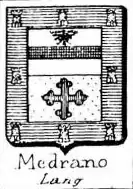Julián Íñiguez de Medrano Lord of Maumusson | |
|---|---|
.svg.png.webp) 1212 AD Shield of the House of Medrano in Navarre "Gules field, Calatrava cross fleurdelisé and voided argent."[2] | |
| Born | Julián Íñiguez de Medrano 1520's Estella, Navarre |
| Died | 1585–1588? |
| Occupation | Novelist, Poet, Playwright, Knight, Explorer, Courtier |
| Language | Spanish, French, Latin, Basque, Castilian etc. |
| Nationality | Navarrese |
| Period | 16th Century |
| Literary movement | Spanish Golden Age |
| Notable works | La Silva Curiosa, dedicated to Queen Margaret of Valois |
| Spouse | Sérène de Montauban (first wife), Francisca de Luca (second wife) |
| Children | Julián Íñiguez de Medrano, Pierre Íñiguez de Medrano, François Iñiguez de Medrano, Marie Iñiguez de Medrano |
| Relatives | Pedro Iñiguez de Medrano (father) María de Ocáriz (mother), 4 brothers |
Julián Íñiguez de Medrano y Ocáriz (Estella, Navarre 1520's–1585-1588?) was an author, knight, poet, and playwright of the Spanish Golden Age, lord of Maumusson, and became part of the court of Queen Margaret of Valois in Nérac. He is known for his book, La Silva Curiosa (Paris, 1583) dedicated to Queen Margaret de Valois. Before becoming familiar with Margaret de Valois, Julián Íñiguez de Medrano had spent many years travelling the world: Spain, Italy, Sicily, France, Flanders, Portugal, the Indies, and Africa. Julián Íñiguez de Médrano, a Navarrese gentleman, illustrious for his knowledge and celebrated for his travels throughout almost the entire world.[3] Medrano was a descendant of Iñigo Arista and the first Kings of Navarre, and a courtier of the Monarchs of Navarre. Julián Íñiguez de Medrano started a prolific lineage of Medrano's, lords of various noble houses in the south of France.[4]
Family and Royal Ancestry
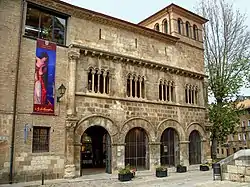
Julián Íñiguez de Medrano was the son of Pedro Íñiguez de Medrano and María de Ocaris (or Ocáriz).[5] His father was from the house of Medrano, ricohombres and ancient Navarrese high nobility from the Kingdom of Navarre; all of them descend from their progenitor, a 10th century Moorish Prince named Don Andres Velaz de Medrano, who came from the Umayyad Caliphate of Cordoba and settled in Igúzquiza.[6] Through his father Pedro Íñiguez de Medrano, Julián claimed he was also a descendant of the Navarrese royal house of Íñiguez, the first Kings of Pamplona (Navarre).[4] A document from the 18th century is preserved, in which the Medrano family provided evidence of their nobility, which includes a family tree. He had four brothers. It was first thought that Julián was from Igúzquiza and born in the 1540's, however it is very possible he was born around the 1520's in Estella.[5] Julián Íñiguez de Medrano was related to the lord of Igúzquiza, Juan Velaz de Medrano y Echauz, born close to him in Estella, where the Medrano family has also owned the Palace of the Kings of Navarre, a Romanesque former royal palace of the Kings and Queens of Navarre from the late 12th century to the mid-15th.[5]
Palace of Íñiguez de Medrano

The Palace of the Íñiguez de Medrano family in Sangüesa is located on Enrique de Labrit street (former Población) nº 31, at the intersection with Calle Caballeros.[7] In the foreground, a double arch at the mouth of the staircase with a central column, decorated with plasterwork. The palace was featured in a printed record of the "Iconographic Museum of the Kingdom" promoted by the Provincial Council. The property is also known as Casa Estudio, for having housed the city's Grammar Study. This 16th-century building has a compact appearance. The ground floor features meticulous ashlar stonework with an lintel doorway and two large windows. The rest of the building is made of brick, adorned with wooden eaves with vegetal motifs, and a gable on the corner.[8]
Marriages and issue
Julián was first married to a certain Francisca de Luca, with whom he had three children. With his second wife, he had one child.
● Julián Íñiguez de Medrano y Luca
● Pierre Íñiguez de Medrano y Montauban
● François Iñiguez de Medrano y Luca
● Marie Iñiguez de Medrano y Luca
One of them, Julián Íñiguez de Medrano y Luca, named after his father, was ordained a priest, and, thanks to the surviving ordination letter, dated 1573. It is known that both de Medrano, father of the ordained, like his mother, Francisca, were originally from Estella.[4]
Sérène de Montauban
When his first wife died, Julián Iñiguez de Medrano went to France, where he was part of the court of the kings of Navarre, Enrique II and Margarita de Angoulême. There is a marriage contract between Julián Íñiguez de Medrano and Sérène de Montauban, dated July 18, 1550; but it seems that Sérène was his second wife. It was precisely because of his place at court, thanks to the intercession of the queen, that Medrano managed to marry Sérène de Montauban, daughter of Bertrand de Montauban, lord of Flourès, Marciac, Riscle and Maumusson.
Lords of Maumusson
Through this marriage, Julián Íñiguez de Medrano became lord of Maumusson, a title that passed to his son Pierre Íñiguez de Medrano y Montauban.[4]
This would mark the beginning of Julian Íñiguez de Medrano's lineage in Gascony. In southern France, they would become abundant and remain loyal to the Kings of France and Navarre, particularly during the 16th century Spanish Conquest of Navarre.[9]
Courtier in the Kingdom of Navarre
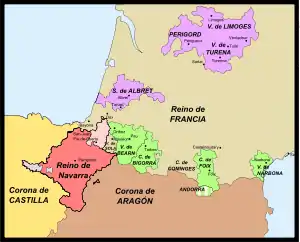
Everything indicates that, indeed, Medrano participated actively in the attempts of Enrique II to recover the part of Navarre occupied by Fernando el Catolico in 1546. In fact, there is a letter from Juan de Vega, ambassador of Carlos V before the Holy See, dated June 9, 1546, in which he mentions a conversation with Pedro de Albret y Navarra, bishop of Cominges, illegitimate son of Juan III of Navarra —stepbrother, therefore, of Enrique II—, and spy imperial in the court of the kings of Navarre, in which he informed him that Enrique II was trying to gain support in Upper Navarre to recover it. To achieve this, he had sent three neighbors from Estella: Tomás de Ubago, Juan Iturmendi and Julián Íñiguez de Medrano.[4]

Julián Íñiguez was not the only knight from the house of Medrano actively taking part in the attempts to recover the Kingdom of Navarre. His relatives the Alcaide Juan Velaz de Medrano y Echauz defended his royal castles of Monjardin and Santacara against Castile in 1512; and his brother the Alcaide and Mayor Jaime Velaz de Medrano y Echauz with his son Luis Velaz de Medrano defended his royal castle of Amauir-Maya in 1522. The lords of Igúzquiza fought for the independent Kingdom of Navarre against the Spanish conquest until it was completed by Emperor Charles V.[10] Subsequently, under the monarchs of Spain, the house of Medrano received royal privileges; once again receiving the title of regents of the Navarrese kingdom two more times in the 17th and 18th centuries.[11][12]
After the death of Henry II of Navarre in 1555, it seems that Julián Iñiguez de Medrano went into the service of Prince Antoine de Borbón, and Juana III de Albret, Queen of Navarre.[4] It may be that he accompanied Antonio de Borbón on his travels around the country during the first war of religion. It is even possible that he fought as a soldier alongside his lord. Medrano, in fact, saw himself as a soldier, rather than as a man of letters: "Some of those who will read this book (La Silva Curiosa) will passionately say that being a soldier, naked and ethereal of the letters and sciences that are necessary to the one who composes some work, why do I get so far ahead and deep into the discourse of women?"[4]
After the demise of Navarre's king consort, Antonie de Borbón, in 1562, there is a gap in information about Julián Íñiguez de Medrano until the 1580s. It's plausible that his journeys around the world occurred during this period, potentially prompted by the changes in the court dynamics following Antonio de Borbón's death. Antonio, after initial uncertainty, eventually aligned with the Catholic side during the first war of religion, meeting his demise in the Siege of Rouen (1591–1592). Medrano likely distanced himself from the Navarre court as Calvinism appeared.[4]
Various testimonials for the travels of Julián Íñiguez de Medrano
An Ode to Julián Íñiguez de Medrano, Knight of Navarre
An Ode to Monsieur Julian Íñiguez de Medrano:
Thus, warlike Cantabria, the glory of Medrano, you reveal, faithful repository of so many labors, all the monuments of your accomplished talent. Expand the riches that fertile Iberia, or monstrous Africa, mother of wonders, or the fields of Italy and Sicily, have offered you. Whatever finally, after a thousand dangers, traversing so many peoples and cities, you, Jule, wise in exploration, bring back unharmed to your homeland. If fate, not civil madness, and force would grant me leisure: if my lyre and the numerous Muse could avail anything in song, I would not allow these many labors of yours to yield to oblivion; nor would any age silence your name, with envy's poison set aside. Not because you possess Indian ivory or the gem-studded shell from the red shore, or veins of fleeing gold hewn from the depths of the earth. May you live dear to noble leaders, the blood of noble ancestors, the Medrano lineage. Not that these things, exposed to the whims of fortune, as my lyre might sing, but rather that your virtue, which is the sanctuary of a pure mind, may be ennobled. For this alone escapes the final pyre every year, while age, rain, fire, and the violent East threaten an end to the others. This, indeed, is the true reward of genuine praise, a fitting recompense for good talents, which afterward, like winged Cosios, will carry you on high, unafraid of being loosed.
— N. L. B., "An Ode to Julián Íñiguez de Medrano, Knight of Navarre," La Silva Curiosa (1583)[13]
Testimony of Ja. Auratus, the Royal Poet
"What various peoples and various cities, the great man of former days, an Ithacan, had seen. But still, he brought nothing back to his paternal home: While plundering others, he robs the sea of its riches. Until, at last, he reached the welcoming company of Alcinous: From there, the guest brought back various treasures to his home. Behold, a new Ulysses, like Julius Medrano, From various peoples, from diverse seas, He brings back every kind of gem and every kind of gold: A treasure as great as that of Ulysses, never before seen.
— Ja. Auratus, the Poet of Royalty." La Silva Curiosa (1583)[14]
Testimony of Benito Selyagio, Hermit of Salamanca
"To senor Medrano: You, who, giving your life to glory, have seen Africa, India, and Italy, and without paling in the midst of dangers, practiced among foreign peoples; You, who have been able to see, over the waters of the Nabataean River, fair Aurora rise in her chariot, and sailing against the North wind, have seen the shore where the sun sets, always inhaling, according to Fortune's whims, the misty air of Neptune's waves; You have not in vain deserved the honor that one wishes to give to immortality, this empty honor, this confused glory that deceives the common people for a time, but by labor elevating your renown, you have engraved your name throughout the world, teaching it to remote islands, giving it to sandy fields, to sea gods, to the inhabitants of the waves, and work, the true father of your destiny, has brought it back to the safe shore where your virtue withdraws from the storm. You have not limited the desire of the beautiful season within the confines of your house in Vendo, your sweet homeland, But as one sees a bee that sifts from meadow to meadow, from garden to garden, from rose to rose, from violet to thyme, a thousand sweetnesses, then returning lightly to its hive, bringing homemaker the sweet gifts of the honeycomb to preserve, and the wax, and the honey; Thus, running, hungry to know the rarities that nature brings forth, you were the first to see the Spanish people, the Portuguese, and both poles; wisely making your profit and glory from what the eye of your soul made you believe: and bringing back labor to our eyes of a hundred treasures, drawn from a thousand places, But what use is it that my pen honors you? you, known to both Auroras, have recognized so many diverse peoples, and surpassed the course of my verses. Your eye, first, discussed things that your learned mind had skillfully unfolded; in seeing them, your eye had pleasure, and your soul chose the most beautiful: which today presents to us the work in this tableau, which we have as a pledge of a longer work, where you outline the features in six discourses, of a hundred thousand secrets."
— Benito Selyagio, Hermit of Salamanca, To Julio Íñiguez de Medrano. La Silva Curiosa (1583)[15]
OMEN OR PROPHECY DRAWN FROM THE FORTUNE AND LIFE OF THE SAID JULIO, BY THE SAME HERMIT, WITH THE ANAGRAM OF HIS NAME. PROPHECY:
"After Julio has crossed land and sea with toil and suffering, Weary of seeing foreign lands, he will return and find rest, And he shall be acclaimed."
— Benito Selyagio, Hermit of Salamanca, To Julio Íñiguez de Medrano. La Silva Curiosa (1583)[15]
Julián Íñiguez de Medrano in the Nérac Court of Queen Margaret of Valois
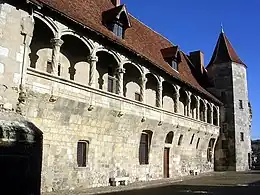
Medrano flourished in the time of Queen Margaret of Valois, and this Princess, who knew how to value people of wit, believed she gained much by having him at her Nérac Court, where he was for several years both an ornament and a delight.[16] In the list of members of the court corresponding to the year 1584 there appears an «escuyer tranchant», equivalent to a gentleman, named «Medranna», who is, without a doubt, Julián Íñiguez de Medrano.[4] Inexplicably, his name does not appear in the lists of previous years, nor in those of subsequent years, hence historians are unsure what capacity he was part of in the court before that date. Medrano resided in France because he belonged to the court of the kings of Navarre.[4]
It can be deduced that Julián Íñiguez de Medrano was around sixty-three years old and occupied a position within the Nérac court.[4] Julián Íñiguez de Medrano also wrote another rare and nearly forgotten work titled "Historia singular de seis animales, d'el Can, d'el Cavallo, d'el Lobo, d'el Osso, d'el Ciervo y d'el Elefante," also printed by Nicolás Chesneau in 1583. Most likely, Medrano shared the humanistic spirit that radiated from the court of his former benefactor, Queen Margaret Angoulême: very critical of the vices of the Roman Church, open to new forms of spirituality, but faithful to orthodoxy.
He had been in Nérac with Queen Margaret of Valois, wife of the future Henry IV: “to the most serene Reyna su Señora etando en Nerac,” is the title of one of his sonnets. Whether he accompanied the queen on her journey from Paris during the second half of 1578, or whether Medrano was already in Nérac upon her arrival, has still been a matter of debate. The fact is that there he became part of her court, although historians are unsure in what capacity; at least until 1584.[4]
La Silva Curiosa ("The Curious Forest") by Julián Íñiguez de Medrano

The full title of his book is "La Sylva Curiosa de Julián de Medrano, Caballero Navarrese, which deals with various very subtle and curious things, very appropriate for Ladies and Gentlemen in all virtuous and honest conversations. Addressed to the very high and most serene Queen of Navarre su Sennora, in Paris, Printed at the House of Nicolas Chesneav, MDLXXXIII." published in 1583 by Nicolas Chesneau and edited by Mercedes Alcalá Galán. Julián Íñiguez de Medrano would have been around sixty-three years old at the time of publishing La Silva Curiosa.[4] Furthermore: Nicolas Chesneau, a well-known Catholic and anti-Huguenot propaganda printer, published La silva curiosa.[14]
Already in 1582 he was in the vicinity of the capital, in Fontainebleau, where the queen asked him to compose his work; later, in the Bois de Vincennes, where he finished it. This information is confirmed by the documents relating to the court of Marguerite de Valois collected by Philippe Lauzun. According to what is said verbatim in the work, rather than to teach the language, Medrano wrote it because the queen had "commanded him to compose a book on Spanish companies and currencies, and some other work in Spanish," of diverse and curious subjects; because she "gets very upset reading the Spanish language."[4]
Medrano wrote it for the amusement of a queen who already knew Spanish and who liked to read it. Pierre de Bourdeille, Lord of Brantôme, stated this when he said that Queen Margaret understood and spoke Spanish and Italian "as if she had been born, raised and raised all her life in Italy and Spain."[4]
Testimony of de la Morinière
"ABOUT THE CURIOUS FOREST OF DE MEDRANO: Let whoever wishes boast about Apelles, Zeuxis, Lisippus, and those closer to our time, Raphael, Michelangelo, and so many experts in their proportions, shading, and variegation. As for me, I value more the tableau of nature, of manners, of teachings, and of the entire universe, which MEDRANO encloses in his beautiful verses, taking the name and figure from a forest. Their portraits only affect our eyes, and hold our idle minds suspended, perishable otherwise and of no memory. But this speaking tableau is much better adorned and cannot be stifled by time in this way, engraving its beautiful art and glory in minds". - Mr. de la Morinière
Republished in 1608 by Cesar Oudin
.jpg.webp)
In the "Rares" room of the Biblioteca Nacional, in Madrid, there are two copies of the two editions of La Silva Curiosa.[4] The second edition of La Silva Curiosa by Julian Iniguez de Medrano (1583) republished in Paris in the year 1608, "corrected in this new edition and improved for readability by César Oudin,"[17] whose main novelty was the inclusion of Cervantes's Novel of the Curious Impertinent. The main novelty here lies in the inclusion of Cervantes' "Novela del curioso impertinente" (Novel of the Inquisitive Impertinent) without any indication of authorship, which led some to believe that this short story was written by Medrano.[4]
This edition is of interest to Cervantes collectors and scholars as it contains an early printing of his Novela del Curioso Impertinente, a story told in Don Quixote, and first published in 1605.[18] It is the final story to appear in this volume of La Silva Curiosa, beginning at page 274. Don Quixote was written when Don Miguel de Cervantes ended up imprisoned in the Cueva de Medrano, located in the centre of the town of Argamasilla de Alba. The place can still be visited nowadays, and it is where, undoubtedly, Don Quixote de la Mancha started to be written.[19]
Poems of Praise dedicated to Queen Margaret de Valois

It was Queen Marguerite de Valois, eager to read texts in Spanish that commissioned Medrano to write La silva curiosa, the work that she would pass on to posterity. The well-known sonnets or poems of praise by Julian Iñiguez de Medrano, both in Latin and in French, and two octaves, are dedicated to Queen Marguerite de Valois:[4]
"I, Most High and Serene Lady (being a native of Navarre and recognizing that the greater part of the honor, being, and fortune I possess, next to God, springs and proceeds from Your Majesty as the true source of my happiness and life), have found this first and tender flower of my labors among the thorns of my sorrows and toils. I removed it from among them, and not knowing anyone who deserves it as much, nor to whom I owe it, I present it to Your Majesty (...) If in this first book Your Majesty enjoys the flowers, in the subsequent ones, you will savor the delicious fruit of the rarest and most curious secrets of nature that I have been able to learn and gather from Spain, the Indies, and my interactions with Italians and Portuguese. Since I have discovered and acquired them with curiosity and labor, I have no doubt that Your Majesty, recognizing my goodwill, will favor them with your attention (...) From this Hermitage in the Bois de Vincennes, on this day of Saint Paul, the twenty-fifth of January, in the year 1583. I kiss the Royal feet of Your Majesty, your most obedient servant, vassal, and subject, Julio Iñiguez de Medrano."[20]
The Works in La Silva Curiosa by Julián Íñiguez de Medrano
Summary of La Silva Curiosa
La Silva Curiosa is a heteroclite miscellany, in which Medrano manifests his penchant for epitaphs, more or less pastoral poetry, proverbs and tales of necromancers and ghosts, and builds a repertoire of entertaining curiosities. The Curious Silva includes very heterogeneous materials within it: sayings, sentences, stories, phrases, nicknames, proverbs, epitaphs, various anecdotes, famous quotes from authorities on various subjects; also poetic compositions and love stories and exotic adventures. Everything is mixed in a motley disorder, already suggested by Silva 's own title.
Julián's stated purpose, as explained in the "Table of the Seven Books of the Silva by Julio Iñiguez de Medrano," was to write seven treatises on different subjects, but Julián only gave the first one to the press, the content of which is summarised in these words: "The first deals with the following subjects: different from many recreational and beneficial things, such as the so-called meanings, letters and short words of Love, and it also contains the most beautiful proverbs, sayings and delicate sentiments that the author has been able to draw and learn among Spaniards, along with many others that the same author has written. Compound. And thou shalt find in him many gentle and funny tales, and some curious epitaphs, found in various lands by Julius himself"[4]
After the epistle of "Julio Iñiguez de Medrano, Navarrese, the Serenísima Reina y Señora," follows a "Table Two of the names of the authors that Julio alleges, with whose authority, together with his experience, he confirms and proves that his work is most true and clean of all suspicion in all things that deal with the hidden secrets of nature." The secrets of nature have a significant presence in the work. Medrano intends to record these secrets in the seventh book.[21]
Furthermore, for the remaining six books, all of them in some way deal with the properties or secrets of nature. The Matter of the remaining projected books:
- The second book deals with the nature of herbs and plants and their rarest, proven, and true virtues.
- The third book discusses the properties and virtues of precious stones and the benefits that can be derived from them, chosen through experience.
- The fourth book teaches the properties, nature, and virtues of many terrestrial animals and reveals many proven secrets obtained from them.
- The fifth book focuses on the properties and nature of fish and the benefits derived from them.
- The sixth book delves into the nature, virtues, and benefits of celestial and terrestrial birds, along with many proven and miraculous secrets.
- The seventh book deals with the secrets of nature.
The first book of La Silva Curiosa
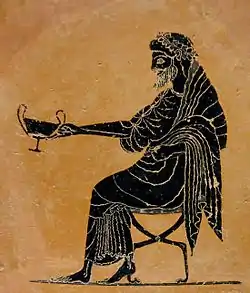
Enigmas, proverbs and games, natural observations of the ancients, curious and true ("for the most part", but not all) accumulate in these pages, where the reader will find examples of palindromes ("To the only Rome, Love to los solos sola"), enigmas ("Vidi hominem non hominem, qui percussit et non percussit avem non avem in arbore non arbore lapide non lapide": he sees a eunuch who strikes a bat perched on an elder tree —tree not quite tree— with a rough stone —limestone, porous, stone that is hardly stone...), goliardic parodies such as the prayer addressed to Bacchus ("Potemus. Oh valde potens, oh fortissime Bacche... Per eundem Bachum qui bibit et potat per pocula poculorum") , or short stories largely copied from Timoneda or Juan Aragonés. Julian Iñiguez de Medrano has a special fondness for epitaphs, of which he collects a good number of all varieties, in Spanish, French and Latin, many of them burlesque, such as that of poor Joan Vitulli, a seventeen-year-old boy, written reluctantly.
The first book of La Silva Curiosa ("The Curious Forest"), the only one still readable, is a set of letters, mottoes, sayings, proverbs, moral sentences, verses... Within this, is the "curious vergel" - this is how Medrano defines his work – various "such senses, sharp answers and very funny and recreational tales, with some curious epitaphs". These stories to which Medrano refers are called anecdotes, jokes, or chascarrillos (stories of few lines; some take up, exceptionally, a little more than a page or a page and a half).
One of Julián Íñiguez de Medrano's short-length narrative pieces in La Silva Curiosa had inspired Lope de Vega, as has been highlighted by critics: Julián Íñiguez de Medrano's comedy "Lo que ha de ser" is about two men who speak ill of women and promise never to marry;[22] however, one of them falls in love and marries a widow, despite rumours about his bad reputation; at the end, the account ends with the indication that he too falls in love with a widow. He was deceived.
The book ends with some laudatory poems and other postliminary texts: "To the most invincible and powerful Caesar Henry III, King of France and Poland, Julius Medrano, Navarrese"; a few verses in Latin: "Ivlius de Medrano, in Lectorem Zoïlum"; the "Prophecy of the Cave of Salamanca for the present year, and then usque ad finem seculi," etc. The colophon is: "Deo volente, navigabo vimine. / O. DE. EC. SE. AS. ME. /End of this Silva's first book."[23]
Medrano's Greek Manuscript: A Translation by Adrien Du Perron De Castera
Julian Iñiguez de Medrano's Greek Manuscript is revealed through the discovery of what is presented as a translation into French of a manuscript found by a certain Adrien Du Perron De Castera in the Abbey of Châtillon (sister-house of Trois-Fontaines Abbey).[24] Indeed, the National Library of Paris holds a small work in whose exact title is as follows: "RELATION OF THE DISCOVERY OF THE TOMB OF THE ENCHANTRESS ORCAVELLE WITH THE TRAGIC HISTORY OF HER LOVES. Translated from the Spanish of Jule Iniguez de Médrane. IN PARIS, Rue de la Harpe, At the Widow HOURY's, opposite Rue S. Severin, at St. Esprit. MDCCXXIX With Approval & Permission. pp. 7"[3]
Testimony from Adrien Du Perron De Castera
The author of this translation, a certain de Castera, after dedicating it "To His Highness Monseigneur de Bouillon de la Tour d'Auvergne, Grand Chamberlain of France, Governor, and Lieutenant General of the Upper and Lower Regions and the Province of Auvergne, Commander of the Turenne Regiment," then goes on to explain the reasons justifying his translation work: "It is not the itch to be seen as an author that compels me to bring this little work to light; I have merely faithfully translated it from the Spanish of Julian Iniguez de Médrano. If there are some noteworthy features found in it, the glory is solely due to him. He flourished in the time of Queen Marguerite of Navarre, and this Princess, who knew how to value people of wit, believed she gained much by having him at her Court, where he was for several years both an ornament and a delight."[3]
Furthermore, he provides interesting but difficult-to-verify information about Medrano's works: "He has two books to his name, with the titles 'Verger fertile' and 'Fóret curieuse,' both of which have had various editions, followed by general acclaim both in France and Spain". With this, it appears to confirm that Medrano carried out his project of writing his "Vergel curioso," to which he might have given the title "Vergel fértil," if at least De Castera's translation is faithful. The following clarification by de Castera states: "The latter has never been printed; I found the manuscript written by Médrane himself in the illustrious Abbey of Châtillon, where, in the intervals of leisure that more serious studies allowed me, I amused myself by adapting it in a French manner."[3]
Adrien Du Perron De Castera relied on nothing less than an autographed manuscript by Medrano. the translator's remarks leave no doubt about his sincerity, as he emphasizes his role as a translator, even expressing doubts about the truth of Medrano's account after comparing this new story of Orcavella with the one already featured in the "Silva curiosa." Médrano presents this work as an absolute truth and asserts that in Colchis, presently called Mingrelia, he actually discovered the Tomb of the Enchantress Orcavella.
-en.svg.png.webp)
Discovery of Medrano's Greek Manuscript: Tomb of the Enchantress Orcavella
Indeed, there is a text where de Castera becomes the narrator of the events that happened to Medrano, who is thus described in the third person:
"Jule Iniguez de Médrano, a Navarrese gentleman, illustrious for his knowledge and celebrated for his travels throughout almost the entire world, recounts that one day, while sitting near Mount Caucasus on a grassy hill, he felt that the grass beneath him was sinking. He moved it aside and saw that it covered a hole the width of a man's body. This hole led to a staircase carved into the rock. Naturally curious, Médrano imagined that it might be an underground passage that perhaps contained some rarity or treasure, and he resolved to descend. To do so, he went to fetch a lantern and, accompanied by a faithful servant, he soon returned to the exact spot he had noticed."[3]
This type of narration continues until the account of Medrano's discovery of a Greek manuscript. This manuscript, which according to De Castera, Medrano claims to have found in a tomb, and contains a confession, in the first person, of a witch named Orcavella, who, after briefly evoking her life as a fat collector, ogress, and vampire, relates the sad story of her love. From there, it could be a faithful translation of Medrano's text, as what precedes clearly corresponds to an account attributable to De Castera, drawing inspiration from the manuscript found in the Abbey of Châtillon and elements from the second part of the 'Silva curiosa.' Historians compared this introductory narrative with the data contained in the miscellany, and found that it coincides with elements in the introductory sections of the Silva and in the account of the journey to Santiago.[3]
For example, Medrano's reputation as a great traveler: "Iniguez de Médrano, a Navarrese gentleman, illustrious for his knowledge and celebrated for his travels throughout almost the entire world..." His natural curiosity and his fondness for the secret and the rare: "... Médrano, naturally curious... Médrano wondered if he should push his curiosity further..." Also, in the continuation of this introductory narrative, there is a reference to the nocturnal birds that Medrano encountered on his journey to Santiago de Compostela when entering the cave of a necromancer, a servant of a holy hermit: "Scarcely had the light he was carrying dissipated the profound darkness that reigned in this cavern when a prodigious quantity of bats, owls, and other nocturnal birds, frightened by his presence, seemed to want to knock him down as they flew tumultuously around him..." Regarding the discovery of drawings on the columns supporting the spacious hall that Medrano reveals, it directly connects to the Navarrese gentleman's fondness for inscriptions, which he eagerly collects in the Silva curiosa.[3]
Death
Julián Íñiguez de Medrano must have died not long after giving his work to print, perhaps before 1588. Almost certainly, his death occurred before the publication of the second edition of La silva in 1608 - which would explain to some extent why Cesar Oudin took the liberty of reducing the original text and adding Cervantes's Curious impertinent.[4] Some indications would point in this direction. In the first place, there is a marriage contract of Medrano's son, Pierre, with Jeanne de Durban, dated August 3, 1588, in which his brothers Julien and François accompany the groom, and his mother Sérène is present, but not so his father. In the second place, there is also an arbitration sentence and partition of assets, dated May 1589, between Pierre de Medrano, Lord of Maumusson, and his brothers, with the authority of Sérène de Montauban. Again, the father is absent, and it seems that the firstborn has already inherited the paternal lordship.[4]
Everything indicates that by then he had died. Guy de Monsembernard even goes so far as to point out that he would have died before 1585, since from that date there is a document in which a daughter of Medrano, Marie, is called the daughter of the "inate Julián de Medrano.” For this very reason, this author flatly denies that, as Carsalade du Pont suggests, Julián de Medrano could be the same Medrano who was involved in a certain conspiracy in 1595 to deliver Bayonne to the Spanish, and who would also appear mentioned in a letter from King Henry IV dated 1602. Perhaps that "Mederano [sic] du Royaume de Navare, et marié en Gasgogne" mentioned in the Histoire du Márechal de Matignon, that "Medrane" mentioned by Henry IV, was one of the children of Julián Íñiguez de Medrano.[25] The Gascon Rolls provides a French variation of Medrano: "Moderano (Mederano)".[26]
Julián's lineage in Southern France
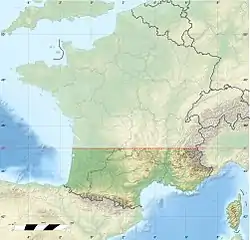
Julián Íñiguez de Medrano started a prolific lineage of Medrano's, lords of various noble houses in the south of France, first located in the region of Gascony since the 16th century. In an 18th century document, a list of six of his descendants is made:[4]
- Antoine de Medrano, Baron de Labassère
- Laurent de Medrano, Lord of Verlus
- Joseph de Medrano, Lord of Coudret
- Jacques de Medrano, Lord of Layan and Coladrey
- Henri de Medrano, Lord of Gouts
- Dominique de Medrano, Lord of Gouts
By the 18th century, the list of lordships in the hands of Julián's descendants in the south of France seems to have been long: "barons of La Bassère, lords of Verlus, Mauhic, Guare, Marquefave, Maumusson, Coudret, Laguian, Coladrey, Gouts, Mont-Pardiac" etc. and they had linked with "the houses of Durban, Cassagnet-Baulat, Sérignac, Mellet, Caissac, and others of good nobility". The Medrano family are one of those noble houses that were so abundant in the sixteenth century. Julian Iniguez de Medrano was a faithful servant of the kings of Navarre in a convulsive moment, thanks to which he managed to gain a small lordship that allowed him to link his children with the nobility of the area.[4]
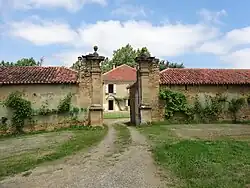
On June 2, 1593, in the noble castle of Verlus in the lower county of Armagnac, Vincent de Verlus, lord of that place, made a "donation of each and every one of his possessions, land of Verlus, lodgings, rents, fiefs, seigneurial rights, etc., to the noble Vincent du Mont, seigneur of that place".[28] However, the de Mont family did not keep the seigneury of Verlus, which had already been owned by the noble Pierre Iñiguez de Medrano before 1640,[29] apparently by inheritance, for in the registers of the same notary (Nogaro's study) one finds, on June 26 In 1611, a marriage contract between Antoine de Mont and Françoise de Medrano was signed. The Medrano family kept Verlus until times close to the Revolution, as well as several other lordships in Armagnac and Pardiac. Jean-Marie de Médrano-Mauhic, Lord of Mauhic (municipality of Averon, Gers), was guillotined at Auch by order of representatives of the Darti-Goeyte and Cavignac people.[9]
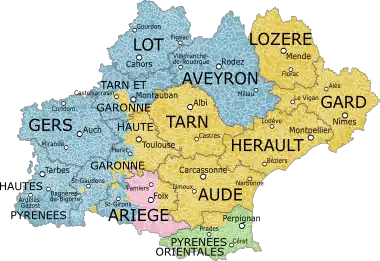
Lords of Mauhic
.jpg.webp)
The Medrano family owned Château de Mauhic in the municipality of Loubédat.[30] The Château de Mauhic is situated in the valleys of the Adour and Arros, and dates back to the 17th century.[31] The Château de Mauhic has a rectangular main building flanked by two square towers. The Château de Mauhic, having belonged to the Médrano family, lords of Mauhic; the last lord Jean-Marie de Médrano-Mauhic was beheaded in 1793, for counter-revolutionary actions. Jean-Marie de Médrano, lord of Mauhic, was guillotined in Auch.[30]
He obtained the title 'lord of Mauhic' a few years after the Abbé de Préchac died in 1732, at Mauhic. In the Kécrologe de Berdoues, the death of the Abbé de Préchac is recorded in November 1732. He had held the title of abbot of Berdoues for thirty-six years. According to the Inventory of the Convent, Jean-Marie de Médrano became his heir. Archives of the Auch Seminary have many papers concerning Medrano, lords of Mauhic, etc. Jean-Marie de Médrano's appointment took place in October 1735. The taking of possession only dates from 1736, the time of the expedition of the Bulls.[32]
Etienne de Médrano, former captain of infantry, residing in Nogaro, was the brother of Jean-Marie Médrano, the former prisoner of Auch, and brother-in-law of Robert Dubernet, resident of Loubédat. The Directory of National Domains in Paris requested payment with the following note: "Confiscation of Médrano-Mauhic property, condemned..." His furniture was made known by Father Camoreyt in his inventory; from "the renowned workshop of Palazo," Father Camoreyt only makes known the most esteemed articles, those which had a greater value, and which were sent first to citizen Tastet, administrator of the district of Nogaro, and then to Paris because of the gold, silver and precious materials that adorned them. It was from Paris or from some large city, which the lord of Mauhic must have brought this furniture, so rich and of great style. It was found at the Château de Mauhic.[30] Jean de Médrano, a knight, Lord of Baulat, Monlezun, etc., born in the diocese of Auch in 1740, married Marie Lefebvre de Ladonchamps in Metz in 1764.[33] In 1784, Jean provided proof of nobility to secure admission to the Military School for his son, Henri-Jacques de Médrano de Baulat, born in Monpardiac in 1772. de Médrano took part in the 1789 assemblies of the nobility held in Lectoure.[33]
Marquisate of Medrano

The County of Armagnac was definitively reunited with the Crown following the accession of Henri IV, in 1589, a few years after Julián Íñiguez de Medrano's death. The Medrano family originates from Navarre, from where they settled in Armagnac very early. They were confirmed in their nobility on April 2, 1697, by the judgment of Sanson, Intendant of Montauban, after proving their lineage since 1550 in the south of France.[33] By the time of King Louis XVI, the ancient house of Medrano had obtained the illustrious Marquisate de Medrano, to which they gave their name. Louis XVI was the last king of France before the fall of the monarchy during the French Revolution. The Marquis de Medrano is recorded in the official minutes, by roll call, or by the signature of the members present at the Estates General of 1789.[33]
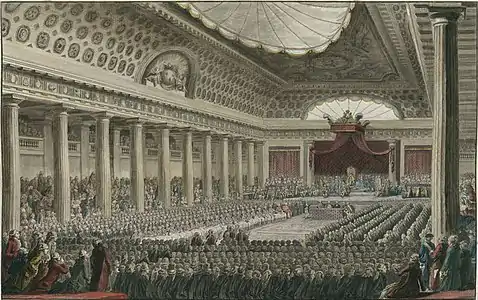
The General Assembly of Lectoure, March 16, 1789: de Medrano, The Marquis de Medrano.[34]
The Marquisate de Medrano was a part of a complete list of the nobility of Armagnac, the senechaussee of Lectoure, which Armagnac embraced almost entirely. Armagnac and Quercy did not form two provinces, but only two Sénéchaussées, administered separately at the time of the convocation of the Assemblies of the Nobility in 1789. They were bordering, and located between Auvergne, Guienne, Gascony and Languedoc; they roughly formed the three departments of Lot, Gers and Tarn-et-Garonne. Records of the Marquis de Medrano are kept in the "Minutes of the General Assembly of the three orders of the seneschalsy of Lectoure. March 16, 1789 (Under King Louis XVI)" in the catalog of the Gentlemen of Armagnac and Quercy who took part or sent their proxy to the Assemblies of the Nobility for the election of Deputies to the Estates General of 1789. Summoned by King Louis XVI, the Estates General of 1789 ended when the Third Estate, along with some members of the other Estates, formed the National Assembly and, against the wishes of the King, invited the other two estates to join. This signaled the outbreak of the French Revolution.[35]
Lords of Gauré
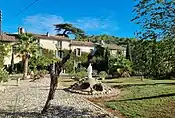
Dona Antionette de Medrano, the mistress of the chateau de Gauré, was born in Spain.[36] Guaré is a commune in the Haute-Garonne department in southwestern France. Her brother, Duke Ramon de Medrano, had been lord of Mauser, Gauré and other places; this very Château de Guaré had been his.[36] However, the Revolution came, and he was guillotined. In order that she herself might not share the fate of her brother, she had fled to Spain, disguised as a goat herder, where she found refuge with her other brother, who was a Bishop. After the Restoration, she had returned to France to claim the estates inherited from her ill-fated brother, the Duke. She had settled in the Chateau de Gaure and had taken into her service as a shepherdess a little girl twelve years old. There, she would also take in a wolf, and named him Pharamond.[36]
Desrousseaux de Médrano Branch
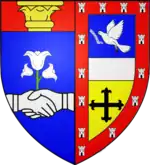
Shortly before the restoration of the French monarchy, the House of Medrano united with the House of Desrousseaux in France (1809), creating the noble Desrousseaux de Médrano branch. Louis-Philippe Desrousseaux, who died in Paris in 1875, married Charlotte-Louise de Médrano in 1809. In September 1866, Louis-Philippe requested and received, by imperial decree on June 22, 1867, the authorization to regularly add the name of the Médrano family to his own, to which his wife belonged.[33] The Desrousseaux family was authorized to join their name to Médrano, and will be dedicated to them in their place. The Desrousseaux family belonged to the great commerce of Sedan in the 18th century.[33] Information about them is stored in the Titles, Ennoblements, and Peerages of the Restoration by Viscount Révérend. He had two sons:
- Charles-Adolphe Desrousseaux de Médrano born in Charleville in 1810, married Me Perrier in 1847, and died in 1876, leaving a son
- François-Henri Desrousseaux de Médrano born in Charleville in 1817, administrator of the Saint-Gobain Glass Company, a Count of the Holy Roman Empire, who married his cousin, Mile Desrousseaux de Vandières, in 1847 and had a son, Édouard, who married Baroness Marthe-Eugénie du Sart de Bouland in 1893 and died without offspring in 1896.
Louis-Philippe Desrousseaux de Medrano's brother Édouard-Charles created the Desrousseaux de Vandières branch when he married his wife and added it to his surname along with the Vandières Estate.[33] His descendant Ange-Alphonse-Edward Desrousseaux de Vandières, born at the Vandières castle in 1866, was a cavalry officer, a knight of honor and devotion of the Order of Malta, and was honored with the title of Roman Duke by a papal brief on February 9, 1909.[33] He made a prestigious connection through his marriage in Lugano in 1901 to Princess Élisabeth d'Ysembourg and Büdingen, a member of one of Germany's most illustrious houses, and the daughter of Bruno, Prince of Ysenburg and Büdingen.[33]
Medrano unites with the Dukes of Gor
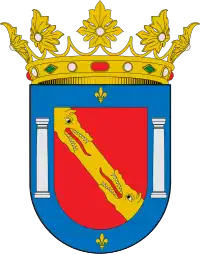
The house of Medrano became Dukes of Gor, Grandee, by marriage. Don Nicolás Mauricio Álvarez de las Asturias Bohorques y Vélez Ladrón de Guevara, Verdugo y Enríquez de Sevilla, I Duke of Gor, married with Doña María del Carmen Chacón de Medrano.[37]
Duchess María del Carmen Chacón Medrano was the daughter of Francisco Chacón-Manrique de Lara Medrano,[38] who in turn was the son of Manuela Tomasa Medrano Angulo (1695), daughter of Andrés de Medrano y Mendizábal, II Count of Torrubia (1654), son of García de Medrano y Alvarez de los Ríos, regent of the Kingdom of Navarre and Seville in the 17th century. Duchess María del Carmen Chacón Medrano was born in Seville on July 17, 1772, and died in Madrid on May 2, 1860, belonging to –by her paternal father Francisco Chacón-Manrique de Lara Medrano (1729-1785)– a branch to the county house of Mollina, and by her maternal mother María del Carmen Carrillo de Albornoz Jacome de Linden (1738) to the ducal of Montemar (de Medrano and de Linden both married on 2 February 1791).[38]
The I Dukes of Gor had a second son named José Alvarez de las Asturias Bohorques y Chacón Medrano (born on January 10, 1794, Barcelona, Cataluña, Spain), Lieutenant Colonel of Cavalry of the National Armies of Spain. José Alvarez married with Maria Josefa Simona Bellvis de Moncada y Palafox Alvarez de Toledo y Portocarrero, XVII Marchioness of Vallhermoso de Tajuña and V Marquesa de Bélgida, Grandee of Spain. The mother in-law of José Alvarez was Maria Benita de los Dolores Palafox y Portocarrero, the legitimate aunt of the Empress of France; being the youngest sister of Cipriano de Palafox, and the youngest daughter of Felipe Palafox y Croy and María Francisca de Sales Portocarrero y Zúñiga. Empress Eugénie de Montijo was born to Cipriano de Palafox, Duke of Peñaranda del Duero, and María Manuela Enriqueta Kirkpatrick de Closbourn y Grevignée.[39]
The Duke of Gor's Library
The origin of the library that has survived into the 20th century, known in Granada as the Duke of Gor's Library, dates back to the late 17th century with the inclusion of a vast collection of books by Don Pedro Verdugo de Albornoz y Ursúa, II Count of Torrepalma. He established the foundations of this library in his house near the Carrera del Darro. Don Pedro spent many years amassing an extensive literary collection, which included various Arabic codices, letters, manuscripts, and poetry from both Luis de Góngora and Francisco Quevedo. The collection also contained several 15th-century incunabula. Pedro Verdugo's successor, Alfonso Verdugo, III Count of Torrepalma and lord of Gor, had a strong interest in literature and continued to expand the library's holdings.[40]
He was also a member of the Poetic Academy El Trípode, which convened at the Sacromonte Abbey. The great-grandson of the library's founder, the II Duke of Gor, acquired the literary collection and established it in his house on Plaza de los Girones. The space, which housed a vast number of volumes, underwent modifications in 1882 and further expansion in 1898. In 1962, the most valuable part of the library was sold by the then Duke of Gor to the bibliophile Don Bartolomé March Servera, who transported it to Madrid to incorporate it into his extensive archive. With over 20,000 volumes, it became one of the finest privately-owned libraries in Spain.[40]
References
- https://www.armorial.org/produit/94328/medrano.html
- ↑ https://www.armorial.org/produit/94328/medrano.html
- 1 2 3 4 5 6 7 https://cvc.cervantes.es/literatura/aiso/pdf/03/aiso_3_3_024.pdf
- 1 2 3 4 5 6 7 8 9 10 11 12 13 14 15 16 17 18 19 20 21 22 23 Indurain, Carlos Mata. "Julián Íñiguez de Medrano, su Silva curiosa (1583) y una anécdota tudelana". Julián Íñiguez de Medrano, su Silva curiosa (1583) y una anécdota tudelana.
- 1 2 3 Indurain, Carlos Mata. "Julián Íñiguez de Medrano, su Silva curiosa (1583) y una anécdota tudelana". Julián Íñiguez de Medrano, su Silva curiosa (1583) y una anécdota tudelana.
- ↑ "MEDRANO - Auñamendi Eusko Entziklopedia". aunamendi.eusko-ikaskuntza.eus. Retrieved 2023-11-09.
- ↑ "SANGÜESA CITY MAP by Turismo Reyno de Navarra - Issuu". issuu.com. 2015-03-30. Retrieved 2023-11-09.
- ↑ z.1234 (2012-06-19). "Palacio Iñiguez de Medrano". Ayuntamiento Sangüesa / Zangozako Udala (in European Spanish). Retrieved 2023-11-09.
{{cite web}}: CS1 maint: numeric names: authors list (link) - 1 2 Archives historiques de la Gascogne (in French). 1888.
- ↑ "Palacio de Velaz de Medrano en Igúzquiza, Navarra | MonumentalNet". www.monumentalnet.org. Retrieved 2023-11-09.
- ↑ "García de Medrano y Álvarez de los Ríos | Real Academia de la Historia". dbe.rah.es. Retrieved 2023-11-09.
- ↑ "Pedro Antonio Medrano Albelda | Real Academia de la Historia". dbe.rah.es. Retrieved 2023-11-09.
- ↑ Julián de Medrano, José María Sbarbi y Osuna (1878). La Silva curiosa (in Spanish). University of Michigan. A. Gomez Fuentenebro. p. 23.
- 1 2 Julián de Medrano, José María Sbarbi y Osuna (1878). La Silva curiosa (in Spanish). University of Michigan. A. Gomez Fuentenebro.
- 1 2 Julián de Medrano, José María Sbarbi y Osuna (1878). La Silva curiosa (in Spanish). University of Michigan. A. Gomez Fuentenebro. p. 25.
- ↑ Yumpu.com. "Otro enigma en torno a Julián Iñíguez de Medrano: las dos Orcavellas". yumpu.com (in Spanish). Retrieved 2023-11-09.
- ↑ Medrano, Julian Iniguez de (1608). La silva curiosa, en que se tratan diversas cosas sotilissimas ... (in Spanish). Orry.
- ↑ "Medrano Julián de (fl circa 1583) La Silva Curiosa". catalogue.swanngalleries.com. Retrieved 2023-11-09.
- ↑ "THE BEGINNING OF EL QUIXOTE IN THE CUEVA DE MEDRANO JAIL – Bodegas Montalvo Wilmot – Finca Los Cerrillos". Retrieved 2023-11-09.
- ↑ "La Silva curiosa". A. Gomez Fuentenebro. 1878.
- ↑ https://dialnet.unirioja.es/descarga/articulo/4221694.pdf
- ↑ La Sylva Curiosa pp. 103-106
- ↑ La Sylva Curiosa p. 169
- ↑ Román d'Amat, Dictionnaire de biographie francaise, Paris, Letouzey, 1970.
- ↑ Histoire du mareschal de Matignon,... avec tout ce qui s'est passé de plus memorable depuis la mort du roy François I. jusqu'à la fin des guerres civiles. Par monsieur de Cailliere,... (in French).
- ↑ "The Gascon Rolls Project". www.gasconrolls.org. Retrieved 2023-11-01.
- ↑ "Medrano Coat of Arms / Family Crest – COADB / Eledge Family Genealogy". coadb.com. Retrieved 2023-11-09.
- ↑ Archives du Gers, series B, Insinuations of the Sénéhaussee of Lectoure
- ↑ Sabazan, notary in Nogaro, and Monlezun, vol. VI, p. 173
- 1 2 3 Société archéologique, historique (1929). "Bulletin de la Société d'histoire et d'archéologie du Gers". gallica.bnf.fr. Retrieved 2023-11-01.
- ↑ https://frenchchateau.net/chateaux-of-midi-pyrenees/chateau-de-mauhic.html
- ↑ General Inventory. Nos. 12942—12964
- 1 2 3 4 5 6 7 8 9 Chaix d'Est-Ange, Gustave (1863-1923) Auteur du texte (1903–1929). Dictionnaire des familles françaises anciennes ou notables à la fin du XIXe siècle. XIV. Des-Dug. - 1915 / par C. d'E.-A. [Chaix d'Est-Ange].
{{cite book}}: CS1 maint: numeric names: authors list (link) - ↑ "Héraldique : base de données". www.euraldic.com. Retrieved 2023-11-01.
- ↑ "Summoning of the Estates General, 1789". Palace of Versailles. 2018-08-23. Retrieved 2023-11-01.
- 1 2 3 Chapter XXX: The Last Wolves of Aignan by Abbé Pierre by Hudson, Jay William, b. 1874; D. Appleton and Company. pbl https://archive.org/stream/abbpierre00compgoog/abbpierre00compgoog_djvu.txt
- ↑ "Family tree of María del Carmen Chacón-Manrique de Lara Carrillo de Albornoz Medrano Jácome de Lienden". Geneanet. Retrieved 2023-11-07.
- 1 2 "Family tree of Francisco Chacón-Manrique de Lara Medrano". Geneanet. Retrieved 2023-11-09.
- ↑ "Family tree of José Álvarez de las Asturias Bohorques Chacón". Geneanet. Retrieved 2023-11-07.
- 1 2 Granada, Rincones de (2017-05-17). "CASA PALACIO DE LOS DUQUES DE GOR - RINCONES DE GRANADA". RINCONES DE GRANADA (in Spanish). Retrieved 2023-11-09.
- Julián Íñiguez de Medrano, su Silva curiosa (1583) y una anécdota tudelana by Carlos Mata Indurain Literary Magazine of the Ribera de Navarra Overpass, no. 19, May 1999, p. 53-56.)
- Another enigma surrounding Julián Iñíguez de Medrano: the two Orcavellas By Andrés Gallego Barnes LESO. Toulouse
- Introducción a la Silva Curiosa de Julián de Medrano, por Mercedes Alcalá Galán, New York: Peter Lang, 1998, ISBN 0-8204-3759-X
- La Silva Curiosa by Julian Iniguez de Medrano
